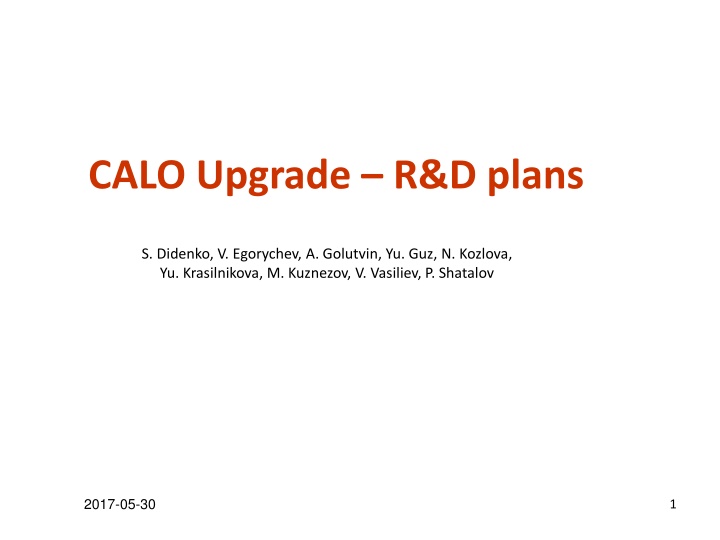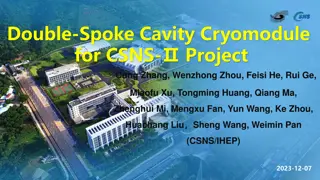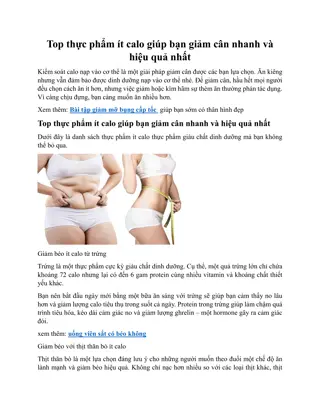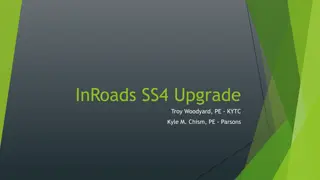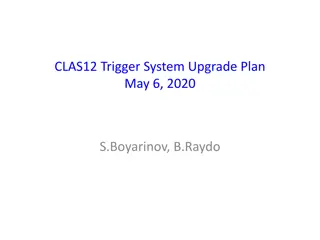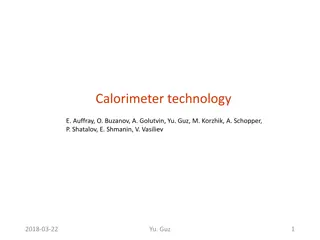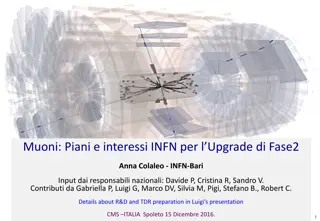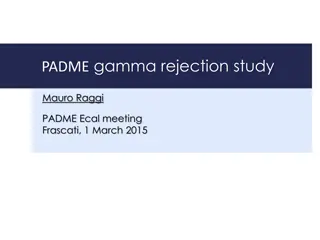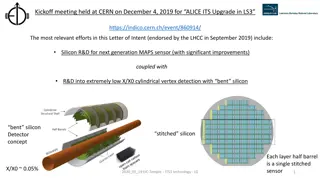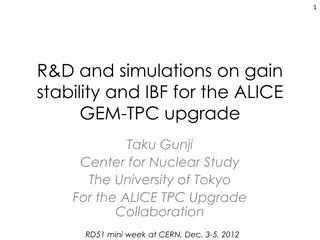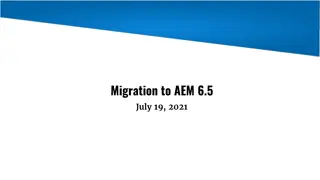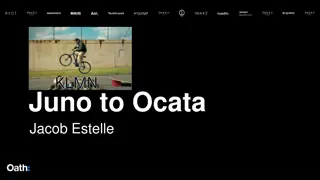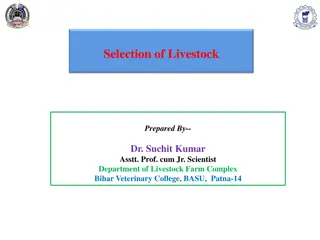CALO Upgrade R&D Plans and Solutions for Future ECAL Technology Selection
The R&D initiative focuses on selecting technology for the central area of Phase II ECAL, aiming for high luminosity and detector performance. Various solutions are proposed, including sampling calorimeters with innovative materials like Ce-doped fibers and radiation-hard scintillators. Plans involve scintillating agent research, irradiation tests, and exploring new materials for light collection. Collaboration with research institutions enhances the project's scope for future advancements in high-energy physics.
Download Presentation

Please find below an Image/Link to download the presentation.
The content on the website is provided AS IS for your information and personal use only. It may not be sold, licensed, or shared on other websites without obtaining consent from the author.If you encounter any issues during the download, it is possible that the publisher has removed the file from their server.
You are allowed to download the files provided on this website for personal or commercial use, subject to the condition that they are used lawfully. All files are the property of their respective owners.
The content on the website is provided AS IS for your information and personal use only. It may not be sold, licensed, or shared on other websites without obtaining consent from the author.
E N D
Presentation Transcript
CALO Upgrade R&D plans S. Didenko, V. Egorychev, A. Golutvin, Yu. Guz, N. Kozlova, Yu. Krasilnikova, M. Kuznezov, V. Vasiliev, P. Shatalov 2017-05-30 1
Introduction The goal of the R&D is technology selection for the central area of the Phase II ECAL: 2*1034 cm-2s-1 ; up to ~ 300 fb-1. We suppose that the lateral geometry of the future ECAL will approximately correspond to the present ECAL layout The main requirements are: small Moli re radius (20 mm or less) ability to work up to TID doses 1-2 MGy / few 1015 1MeV neq regular replacements can be considered ability to work at 25 ns bunch crossing time we do not need extreme energy resolution in this region: is sufficient; the equivalent light yield for the light detection with a PMT with bialcali photo cathode should be > few hundred photo electrons per 1 GeV A constraint: we would like to avoid solutions which require cooling of the (whole) detector 10 ( 15 )% [ ] 1 ( )% 2 E GeV 2017-05-30 2
Introduction To achieve this, we can explore several solutions. Some of them are known and developed during long time, others can be new sampling calorimeter composed of W converter and radiation hard scintillator, inorganic or organic machinable W alloy Ce doped quartz fibers as WLS; thin quartz plate as a light guide, instead of WLS fibers homogeneous calorimeter made of heavy inorganic scintillator, e.g., LYSO, PWO; homogeneous Cerenkov calorimeter based on KRS-6 (Thallium Bromo-Chloride solid solution) or NBW (NaBi(WO4)2) crystals (fast signal); sampling W-Si calorimeter - ? (needs detector cooling?) A 3-year grant was obtained (Andrey) to work on the ECAL R&D, together with MISIS (a material science university in Moscow) 2017-05-30 3
Plans At the first stage, the following studies are planned: Review of existing and research of new scintillating agents meet the requirements of LHCb calorimeter (MISIS) Irradiation tests radiation hardness studies of KRS-6 and NBW samples shall be obtained from GIREDMET radiation hardness studies of polystyrene / polyvinyltoluene based plastic scintillator 2017-05-30 4
Plans (contd) Beam and laboratory tests (ITEP, CERN, MISIS) irradiation tests and light yield measurements of KRS-6 and NBW based calorimeter cell in various configurations; search of new radiation hard materials for light collection in sampling calorimeters: thin( 1-2 mm) quartz plates as a light guide; quartz ( or another inorganic) fibers doped with cerium as a shifter. development of the W machining technique / machinable W alloy Few prototypes with scintillator light guide structure are ready to be studied at SPS in September 2017 2017-05-30 5
ECAL periphery To work at 2 1034 cm-2s-1, we may need to improve granularity also at the periphery These modules can be also Shashlik, but with finer granularity significant number of 9-ch Inner type modules (4x4 cm2) may be needed to replace 4-ch and 1-ch; it is also possible to build 16-channel (3x3 cm2) Shashlik modules at the same technology smaller Moliere radius can be achieved by changing the scintillator-lead volume ratio: for 1:1 the Moliere radius will be 2.7 cm, which is compatible with the cell size, 30 cm some R&D is planned to optimize the light yield and energy resolution for such modules first prototypes will be studied at SPS in September 2017 all types of Pb-Scint Shashlik can be produced at existing facilities in Russia 2017-05-30 6
conclusion The R&D on ECAL technology selection is starting ideas / suggestions are welcome! 2017-05-30 7
spares 2017-05-30 8
Pb:Sc and W:Sc, different Moliere radii RM=36 mm Pb:Sc RM=30 mm Pb:Sc RM=25 mm Pb:Sc RM=20 mm Pb:Sc W:Sc W:Sc W:Sc W:Sc volume ratio 1:2 1:4.6 1:1.28 1:3.25 1:0.77 1:2.3 1:0.315 1:1.46 Sc mass frac % 15.7 20.2 10.7 15.1 6.7 11.2 2.9 7.4 av density, g/cm3 4.49 4.31 5.57 5.35 6.87 6.59 8.88 8.47 rad len, cm 1.639 1.888 1.258 1.449 0.983 1.134 0.735 0.851 Present ECAL 2017-05-30 9
2017-05-30 10
ECAL periphery LS3 is between LHC Run 3 and Run 4, in both LHCb will at 2 1033 cm-2s-1; ECAL granularity is supposed to be improved in LS3 at the horizontal band (see slides of Fr d ric) one of the options is to improve the granularity (at the periphery) according to the requirements of Run 5, 2 1034 cm-2s-1 already in LS3; this may require to rebuild even a larger ECAL area (more than the inner horizontal band) 2017-05-30 11
ECAL periphery The ECAL modules at the periphery do not need to be built at a rad-hard technique can be also Shashlik, but with finer granularity significant number of present 9-ch Inner type modules (4x4 cm2) will have to be produced to replace 4-ch and 1-ch; it is also possible to build 16-channel (3x3 cm2) Shashlik modules at the same technology smaller Moliere radius can be achieved by changing the scintillator-lead volume ratio: for 1:1 the Moliere radius will be 2.7 cm, which is compatible with the cell size, 30 cm some R&D is planned to optimize the light yield and energy resolution for such modules first prototypes will be studied at SPS in September 2017 all types of Pb-Scint Shashlik can be produced at existing facilities in Russia 2017-05-30 12
